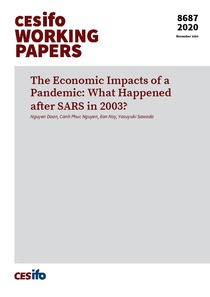The economic impacts of a pandemic: what happened after SARS in 2003?

Doan, Nguyen ; Nguyen, Canh Phuc ; Noy, Ilan ; Sawada, Yasuyuki
CESifo - Munich
2020
30 p.
epidemic disease ; economic impact ; economy ; economic recovery
CESifo working paper
8687
Economics
English
Bibliogr.
"This study quantifies the economic impacts of SARS on the four affected Asian economies and the two most affected Chinese regions using synthetic control methods with macroeconomic and remote-sensing nightlight data. For the four affected economies (China, Hong Kong, Taiwan, and Singapore), we find only very short-term identifiable adverse impact on per capita GDP. These economies grew at a very fast pace in the post-SARS period, showing a strong V-shaped recovery. We detect a persistent decrease of 2-4 percent in the affected Chinese regions, Guangdong and Beijing; and this identifiable downturn appears to be robust to placebo analysis with standard synthetic control methods, but not when using the Augmented Synthetic Control method (ASCM). The ASCM analysis suggests that even the decline in the most heavily affected Chinese regions was fairly short lived. Overall, these finding suggests that the benign picture that emerges from the analysis of national-level data might be somewhat misleading; but that SARS did not eventually lead to statistically observable declines in economic activity, given its relatively limited spread to other countries, and the affected countries ability to stop its spread within very quickly. Obviously, by now it is clear that the picture emerging for COVID-19 is very different."
Digital
The ETUI is co-funded by the European Union. Views and opinions expressed are however those of the author(s) only and do not necessarily reflect those of the European Union or the ETUI.